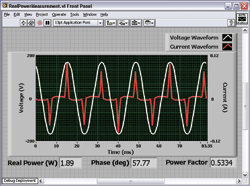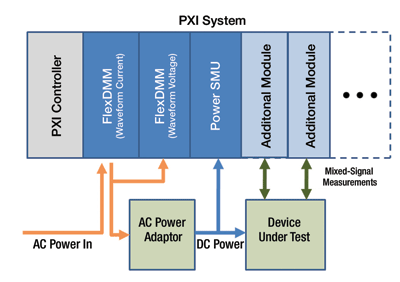Measure inefficiencies accurately, then fix them
Save energy by accurately characterizing vampire currents and converter inefficiencies
BY TRAVIS WHITE
National Instruments
Austin, TX
http://www.ni.com
Engineers and scientists around the globe are stepping up to the challenges of energy conservation. One challenge, the “One Watt Initiative,” is working to drastically scale back losses due to “vampire currents,” which waste energy on billions of devices worldwide. Another, the Energy Star program, aims to push the efficiencies of these devices well past what the law requires.
However, before engineers can fix a design problem to improve efficiency, they first need a way to accurately measure and characterize the problem. Because energy conservation is an ongoing battle, engineers and scientists must have a diverse set of tools to deal with new and changing requirements.
A good example is an ac power adapter plugged into a wall outlet. These external transformers, or “wall warts,” that convert ac to dc power for billions of devices, are seldom designed for efficiency or standby performance. They consume power, via what are called “vampire currents,” even when their associated devices are disconnected because transformer leakage results in continuous ac current losses.
Larger devices often use internal transformers, but they share the same issues of poor efficiency during operation and wasted energy in standby mode. Studies estimate that as much as 10% of residential energy is wasted on vampire currents alone.
Standby case
Consider the simple case of characterizing the standby performance of an ac power adapter for a new mobile device. A common way of measuring the power lost to vampire currents is to simply measure the ac current draw with a DMM and multiply by the rms voltage of the source.
However, this assumes that the circuit is resistive and power input is purely sinusoidal. Changes in the shape of the input voltage or current draw as well as the phase difference between the input voltage and consumed current can yield significant differences in calculated power draw.
A more accurate depiction of power loss can be obtained by measuring the true power or “real power” of the device — an operation that must take into account both signal shape and phase. One method of analyzing true power is to use two synchronized National Instruments PXI-4071 FlexDMM devices, each of which provides the ability to acquire voltage and current waveforms at up to 1.8 Msamples/s, in addition to a standard DMM readout.
Figure 1 is a graph of the voltage and current waveforms as measured by two FlexDMMs, and the resulting time-averaged true power measurement. One of the FlexDMMs measured the voltage applied to an ac adapter while another was placed in series to measure the current waveform. In this case, the real power wasted by the adapter under test was measured to be 1.89 W — better than some, but obviously not yet up to the level of performance called for by the One Watt Initiative.

Fig. 1. Measuring real power requires knowledge of signal amplitude, shape, and phase.
Accurate active measurement
Now let’s consider measuring efficiency while active, requiring the ability to measure the true ac input and the dc power output simultaneously. This load test should be done at multiple output load levels.
Typically, engineers accomplish this by using a simple variable resistance load. Another method, with increased flexibility, is to use a source measure unit (SMU) on the dc output of the adapter. SMUs offer four-quadrant outputs capable of sinking current.
This method can be integrated into the previously mentioned PXI-based system using a PXI-4130 power SMU, providing a constant load current. The same SMU can be used to measure the dc voltage out as well as the dc current, to get the power, and this can be compared to a true power measurement to determine conversion efficiency at various load levels. For a more detailed characterization, engineers can sweep the SMU current draw across a range, from no load to maximum loading conditions.
Wasted power, of course, is not limited to ac adapters. Many devices have leakage currents when inactive or off that result in wasted power. To characterize such effects, engineers can use the same PXI test system (see Fig. 2 ) consisting of two DMMs and an SMU to test the power consumption of a device in a variety of operational states.
In this scenario, the input ac power is disconnected and the PXI-4130 SMU is used as the dc source for the device. Engineers can condition the device into active, low-power, and quiescent states and characterize the resulting dynamic current and leakage current with down to nanoampere resolution.
For a more rigorous low-power test, some devices can be set into a variety of quiescent states that independently enable sections of the internal circuitry. By continuously monitoring the current consumption as these sections are enabled, it is possible to analyze if any one section is defective and thereby gain a more detailed analysis of a device’s performance. Again, the PXI SMU can be used to provide power and measure the current consumption, and an additional digital interfacing module can be added to condition the device into the appropriate state.

Fig. 2. A versatile PXI test system will aid the measurement of actual product energy efficiencies.
The PXI-based solution initially provided the ability to easily synchronize multiple high-voltage waveform acquisitions as well as meet other test requirements through the addition of various modular instruments. Measurements such as transformer efficiency as a function of load and device power consumption in different operational states were then accommodated through the addition of a single SMU. It could also be valuable to augment the power measurements on the mobile device with audio, video, or RF measurements to identify how the power consumption correlates with device performance in different usage modes. Because engineers control all of the instruments in the system from a single PXI controller, they can automate the measurements as well as analyze and display the results with the use of a single programming environment such as National Instruments LabVIEW. ■
For more on current and power measurement, visit http://www2.electronicproducts.com/test-measurement.aspx.
Advertisement
Learn more about National Instruments





